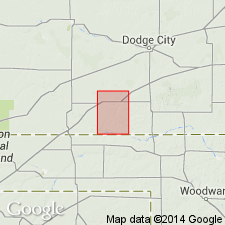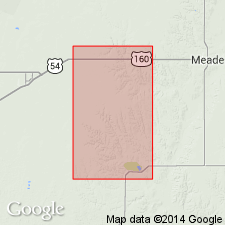
- Usage in publication:
-
- Missler member
- Modifications:
-
- Original reference
- Dominant lithology:
-
- Silt
- AAPG geologic province:
-
- Anadarko basin
Summary:
Pg. 67-68. Missler member of Meade formation. Name applied to beds overlying Meade gravels member (new) of Meade formation and underlying Stump Arroyo member of Crooked Creek formation (both new). Consists of reddish sandy silt. Thickness 17 feet. Fossils (Deer Park fauna). Age is Pleistocene.
Type locality: along tributary of Spring Creek, in secs. 6 and 7, T. 32 S., R. 28 W., Meade Co., southwestern KS. Named from town of Missler on Rock Island RR, in sec. 26, T. 31 S., R. 29 W., about 2.5 mi northwest of type locality.
Source: Publication; US geologic names lexicon (USGS Bull. 1200, p. 2530).

- Usage in publication:
-
- Missler member
- Modifications:
-
- Revised
- AAPG geologic province:
-
- Anadarko basin
Summary:
Pg. 55 (fig. 1), 56. Missler member of Ballard formation of Meade group. Reallocated to member status in Ballard formation (new). Overlies Angell member (new). Unconformably underlies Stump Arroyo member of Crooked Creek formation. Fossils (Sanders, Deer Park, and Dixon local faunas). Age is Pleistocene (Nebraskan-Aftonian).
Source: Publication; US geologic names lexicon (USGS Bull. 1200, p. 2530).
- Usage in publication:
-
- Missler Silt Member
- Modifications:
-
- Age modified
- Biostratigraphic dating
- AAPG geologic province:
-
- Anadarko basin
Zakrzewski, R.J., 1975, Pleistocene stratigraphy and paleontology in western Kansas; The state of the art, 1974: University of Michigan, Museum of Paleontology Papers on Paleontology, no. 12., Claude W. Hibbard Memorial Volume, no. 3
Summary:
Pg. 122 (fig. 1), 124 (fig. 2), 125 (fig. 3), 126. Missler Silt Member of Ballard Formation. Lies below Stump Arroyo Member of Crooked Creek Formation and above Angell Gravel Member of Ballard Formation. Fossils (Sanders, Deer Park, and Spring Creek local faunas). Age is Pliocene (Blancan NALMA); Pliocene-Pleistocene boundary placed at base of Irvingtonian NALMA (base of Nebraskan-Aftonian), = 1.8 Ma.
Source: Publication.
For more information, please contact Nancy Stamm, Geologic Names Committee Secretary.
Asterisk (*) indicates published by U.S. Geological Survey authors.
"No current usage" (†) implies that a name has been abandoned or has fallen into disuse. Former usage and, if known, replacement name given in parentheses ( ).
Slash (/) indicates name conflicts with nomenclatural guidelines (CSN, 1933; ACSN, 1961, 1970; NACSN, 1983, 2005, 2021). May be explained within brackets ([ ]).

